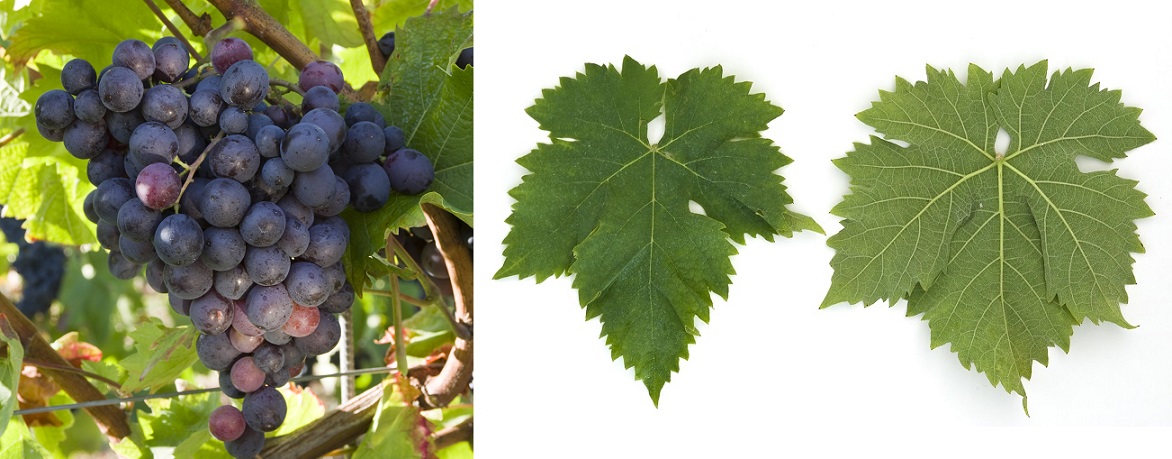The red grape variety possibly originates from England. There are around 100 synonyms that indicate a wide distribution. The most important, grouped alphabetically by country, are Black Muscat (Australia), Muscat Albertdient's (Belgium), Moscatel de Hamburgo (Brazil), Muskat-Trollinger, Trollinger-Muskat (Germany), Black Muscat, Black Muscat of Alexandria, Muscat Hamburgh, Snow's Muscat Hamburgh, Venn's Seedling, Venn's Seedling Black Muscat (England), Hamburg Musqué, Muscat de Hamburg, Oeillade Musquée (France), Moschato Amvourgou, Moschato Tyrnavou (Greece), Gulabi (India), Malvasia Nera, Moscato d'Amburgo, Moscato Nero, Moscato Nero d'Acqui, Zibibbo Nero (Italy), Muscat Hamburg Crni (Croatia), Moscatel Prato (Portugal), Tămâioasă Hamburg, Tămâioasă Neagră(Romania), Moscatel de Hamburgo (Spain, Uruguay), Hamburgii Muskotály (Hungary), Black Hamburg, Black Muscat, Muscat Hamburg (USA, Cyprus).

Parentage
It should not be confused with the varieties Aleatico (Moscato Nero) or Moschomavro, despite seemingly suggestive synonyms or morphological similarities. According to the latest DNA analyses carried out in 2015, it is a cross between Schiava Grossa x Muscat d'Alexandrie (which also explains the extremely confusing synonym Black Muscat of Alexandria). The ampelographers Alberto Piròvano (1884-1973) and Louis Levadoux had already correctly surmised this. The variety was introduced in the trade journal "London Florist" in 1858 and the horticulturist Seward Snow was quoted as describing it as the result of a cross between Black Hamburg (Schiava Grossa) x White Muscat (Muscat d'Alexandrie). However, it is not clear by whom and where exactly the cross was made.
According to one hypothesis, it was cultivated in greenhouses in Hamburg from the mid-1830s and travelled from there to England around 1850. The Black Muscat of Alexandria mentioned by the British botanist William Forsythe (1737-1804) in 1802 is probably a colour mutation of Muscat d'Alexandrie (confusingly, Black Muscat of Alexandria is also a synonym for Muscat d'Hamburg). The variety was grown in large quantities in greenhouses in England by Snow and a colleague called Venn (see synonyms) and from there it spread all over the world. An open-pollinated seedling of Muscat d'Hamburg in Italy is the variety Moscato d'Adda.
Descendants
Due to its favourable characteristics, Muscat d'Hamburg was a popular crossing partner for many new varieties of wine grapes and table grapes. In China in particular, many crosses were made with the Asian species Vitis amurensis. Among others, it was a parent of the varieties Academica, Adelaide, Algarvia, Alphonse Lavallée, Aminia, Amur, Amurg, Angelo Pirovano, Anmeigui, Balada (2), Barkhatnyi, Bashkanskii Krasnyi, Beichun, Campbell Early, Canada Muscat, Candin, Complexa, Donaris, Dostoinyi, Early Muscat, Edelsteiner, Exalta, Fioletovy Ranny, Franca, Giovanna, Golden Muscat, Italia, Kalina (2), Kossuth Ferenc, Liana, Manzoni Moscato, Mills, Mindelo, Misket Dunavski, Misket Kailachki, Misket Plevenski, Moscargo, Moscatel Nazareno, Muscat Bailey A, New York Muscat, Oberon, Oeillade de Conzieu, Perlona, Pierrelle, Pobeda, Quanlongzhu, Quanyu, Quassaic, Santarena, Șarbă, Schönburger, Super Hamburg, Tentaçao, Teresita, Triunfo, Vera Cruz, Viola, Xenia, Yan 73, Yulski Biser, Yüluzhu and Zeyu.
Characteristics
This medium-ripening, high-yielding vine produces rather light-alcohol, ruby-coloured red wines with a subtly pronounced muscat tone. However, the variety is mainly used worldwide as table grape and is therefore often cultivated in greenhouses.
Cultivation areas
In the department of Vaucluse (southern Rhône), there is a table grape AOC called Muscat du Ventoux. It is cultivated in Germany as a wine grape under the name Muscat Trollinger and its cultivation can be traced back to 1850. The area under cultivation here is 113 hectares, of which 109 hectares are in the Württemberg growing region.
Other areas are cultivated in Australia (35 ha), France (2,325 ha), Greece (2,288 ha), Italy (22 ha), Moldova (254 ha), North Macedonia (350 ha), Spain (125 ha), Russia (180 ha), Serbia (624 ha), Switzerland (0.1 ha), Hungary (12 ha), Uruguay (1,267 ha) and the USA, mainly California (113 ha). In 2016, a total of 7,680 hectares of vineyards were reported with a downward trend. This puts the variety in 90th place in the global grape variety ranking (Kym Anderson statistics).
Pictures: Ursula Brühl, Doris Schneider, Julius Kühn Institute (JKI)
Voices of our members

For me, Lexicon from wein.plus is the most comprehensive and best source of information about wine currently available.
Egon Mark
Diplom-Sommelier, Weinakademiker und Weinberater, Volders (Österreich)